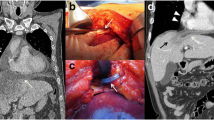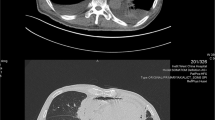Abstract
Purulent pericardial effusion is a rare and life-threatening complication of pyogenic liver abscess if not diagnosed and intervened early. Due to its nonspecific presentation, diagnosis of pyogenic liver abscess is challenging. Herein, we discuss the case of a 31-year-old healthy male that presented with acute chest tightness for one day in the setting of spontaneous rupture of pyogenic liver abscess and developed transdiaphragmatic extension of purulent pericardial effusion. The abscess resolved with antibiotic therapy (beta-lactam), ultrasound-guided aspiration, and pericardial window. Culture of pericardial fluid yielded the Streptococcus anginosus group. He was subsequently discharged following clinical resolution and normalization of liver function tests after 15 days of treatment. Follow-up ultrasonography revealed that the liver abscess and pericardial effusion were resolved in 8 weeks post treatment and intervention.




Similar content being viewed by others
References
Dsouza R, Roopavathana B, Chase S, et al. Streptococcus constellatus: a rare causative agent of pyogenic liver abscess. BMJ Case Rep. 2019;12:e229738.
Kaplan GG, Gregson DB, Laupland KB. Population-based study of the epidemiology of and the risk factors for pyogenic liver abscess. Clin Gastroenterol Hepatol. 2004;2:1032–8.
Tsai FC, Huang YT, Chang LY, et al. Pyogenic liver abscess as endemic disease, Taiwan. Emerg Infect Dis. 2008;14:1592–600.
Mayor JS, Robalo MM, Pacheco AP, et al. Pyogenic liver abscess: uncommon presentation. BMJ Case Rep. 2016;2016:bcr2016214841.
Serraino C, Elia C, Bracco C, et al. Characteristics and management of pyogenic liver abscess: a European experience. Medicine. 2018;97:e0628.
Mark Feldman LSFMHS. Sleisenger and Fordtran's gastrointestinal and liver disease: pathophysiology, diagnosis, management. New York: Elsevier; 2002.
Luo M, Yang XX, Tan B, et al. Distribution of common pathogens in patients with pyogenic liver abscess in China: a meta-analysis. Eur J Clin Microbiol Infect Dis. 2016;35:1557–655.
Chong VH, Zainal-Abidin Z, Hassan H, et al. Rare complications of pyogenic liver abscess. Singap Med J. 2010;51:e169–e172172.
Jun CH, Yoon JH, Wi JW, et al. Risk factors and clinical outcomes for spontaneous rupture of pyogenic liver abscess. J Dig Dis. 2015;16:31–6.
Lee C-H, Leu H-S, Wu T-S, et al. Risk factors for spontaneous rupture of liver abscess caused by Klebsiella pneumoniae. Diagn Microbiol Infect Dis. 2005;52:79–84.
Cho E, Park SW, Jun CH, et al. A rare case of pericarditis and pleural empyema secondary to transdiaphragmatic extension of pyogenic liver abscess. BMC Infect Dis. 2018;18:40.
Rawla P, Vellipuram AR, Bandaru SS, et al. Colon carcinoma presenting as Streptococcus anginosus bacteremia and liver abscess. Gastroenterol Res. 2017;10:376–9.
Mohanty S, Panigrahi MK, Turuk J, et al. Liver abscess due to Streptococcus constellatus in an immunocompetent adult: a less known entity. J Natl Med Assoc. 2018;110:591–5.
Gana TM, Awolaran O, Akhtar S. Streptococcus milleri and recurrent intra-abdominal abscesses: a case report and literature review. Case Rep Surg. 2016;2016:6297953.
Gilbert DN, Eliopoulos GM, Chambers HF, Saag MS, editors. The Sanford guide to antimicrobial therapy 2019. Sperryville: Therapy Inc; 2019.
Hanna A, Imam Z, Odish F, et al. Multiple liver abscesses caused by Streptococcus intermedius bacteremia in the setting of a routine dental cleaning. BMJ Case Rep. 2020;13:e233097.
Akuzawa N, Hatori T, Kitahara Y, et al. Multiple liver abscesses and bacteremia caused by Streptococcus constellatus infection: a case report. Clin Case Rep. 2016;5:69–74.
Benou C, Walter BM, Schlitter MA, et al. Gastrointestinal stromal tumor as entry port for S. intermedius causing bacteremia and multiple liver abscesses. Case report and review of literature. Z Gastroenterol. 2016;54:245–9.
Masood U, Sharma A, Lowe D, et al. Colorectal cancer associated with Streptococcus anginosus bacteremia and liver abscesses. Case Rep Gastroenterol. 2016;10:769–74.
Livingston LV, Perez-Colon E. Streptococcus intermedius bacteremia and liver abscess following a routine dental cleaning. Case Rep Infect Dis. 2014;214:954046.
Neumayr A, Kubitz R, Bode JG, et al. Multiple liver abscesses with isolation of Streptococcus intermedius related to a pyogenic dental infection in an immuno-competent patient. Eur J Med Res. 2010;15:319–22.
Rodrigues ALS, Soares MCP, Ramos FLP, et al. Multiple pyogenic liver abscesses caused by Streptococcus constellatus in the Amazon region. Case report Ann Hepatol. 2009;8:255–7.
Tran MP, Caldwell-McMillan M, Khalife W, et al. Streptococcus intermedius causing infective endocarditis and abscesses: a report of three cases and review of the literature. BMC Infect Dis. 2008;8:154.
Bateman NT, Eykyn SJ, Phillips I. Pyogenic liver abscess caused by Streptococcus milleri. Lancet (London, England). 1975;1:657–9.
Funding
None.
Author information
Authors and Affiliations
Contributions
Conception and design: TP, AC; review and data collection: TP, KA, WP, AR; draft of the article, provision of table and figures: TP, KA, WP; study supervision and final approval of the version: AC; all authors contributed important intellectual content and approved the final version of the manuscript.
Corresponding author
Ethics declarations
Conflict of interest
Drs. Tanaporn Prateepchaiboon, Keerati Akarapatima, Warut Pisudtinontakul, Attapon Rattanasupa, and Arunchai Chang have no conflicts of interest or financial ties to disclose.
Patient consent for publication
Obtained.
Provenance and peer review
Not commissioned, externally peer reviewed.
Additional information
Publisher's Note
Springer Nature remains neutral with regard to jurisdictional claims in published maps and institutional affiliations.
Rights and permissions
About this article
Cite this article
Prateepchaiboon, T., Akarapatima, K., Pisudtinontakul, W. et al. A rare case of massive pericardial effusion due to spontaneous rupture of Streptococcus anginosus group liver abscess. Clin J Gastroenterol 13, 1258–1264 (2020). https://doi.org/10.1007/s12328-020-01196-3
Received:
Accepted:
Published:
Issue Date:
DOI: https://doi.org/10.1007/s12328-020-01196-3




